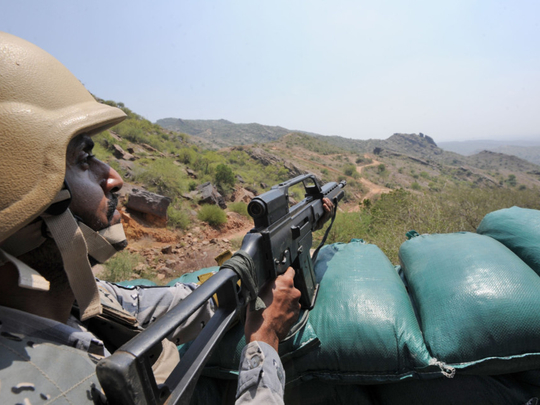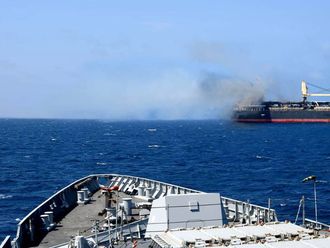
Al Khubah: Gas masks lie abandoned among rusting debris in a shell-pocked Saudi military outpost on the border with war-torn Yemen, an enduring flashpoint in more than two years of fighting against Al Houthi rebels.
The post in Al Khubah, a deserted village framed by barren mountain ridges, is one of several border guard bases the rebels have targeted since a Saudi-led coalition began its military intervention in Yemen in 2015.
The Iran-backed insurgents’ hit-and-run incursions and rocket barrages have not jeopardised Saudi control of the vast frontier, but they have underscored how the raging conflict in Yemen is spilling across the border, threatening scores of villages like Al Khubah.
“Al Houthis thought we will withdraw,” Saudi border guard Colonel Mohammad Al Hameed said as he gave AFP a rare tour of the battered base.
“But we are still very much in control,” he added, broken glass and bullet casings crunching under his feet.
The base showed signs of close-range combat. The scorched walls were scarred with shrapnel and the metal ceiling was pitted with bullet and shell holes. A cat prowled behind a mountain of wrecked furniture.
Gas masks had been procured for fear of potential chemical attacks, Al Hameed said.
He described the Saudi base on the edge of the frontier as an “arrowhead”, directly exposed to Al Houthi mountain posts on the other side that give the rebels a strategic vantage point.
The rebels, well-versed in the region’s rugged topography, have mounted numerous cross-border raids. Saudi Arabia led a 2015 intervention in Yemen to restore the legitimate and internationally-recognised government of President Abd Rabbo Mansour Hadi after Al Houthi rebels carried out a coup in 2014.
The rebels have posted numerous propaganda videos purporting to show their incursions into Saudi territory, including one inside Al Khubah.
“Al Houthis are liars, liars, liars,” Al Hameed said, saying there had only been a handful of Saudi casualties and no fatalities in rebel assaults at the site.
Saudi Arabia does not officially disclose military fatalities, but state media has frequently featured funeral notices for martyred soldiers.
Given Saudi Arabia’s large military presence along the border and its superior air power, Al Houthis would struggle to hold any territory they might seize.
Ordinary Saudi civilians have also been affected by the fighting. Thousands of residents have been evacuated from border towns across the southwest to create a buffer zone. The provinces of Jizan and Najran have been particularly affected.
In the frontier provinces of Jizan and Najran, thousands of mortar shells and crude rockets have slammed into schools, mosques and homes.
But life has remained normal.
“City hall. Normal. Hospital. Normal. School. Normal,” Al Hameed said as he drove past the sites en route to Al Khubah.
“You are near the war but you will say ‘where is the war?’ We have successfully sealed the border.” Thousands of residents living in border communities have been moved to safer ground. Crashing mortar shells have left large craters in the ground.
“Al Houthis are a cancer,” Al Hameed said. “If you have power, target us. Why kill civilians, women and children?”
The UN has criticised Al Houthis for indiscriminate shelling of civilian targets.
But for border guards, the threat emanating from Yemen is existential.
Al Hameed ducked slightly as he got out of his armoured vehicle, for fear of Al Houthi snipers and fighters lurking in the hills.
He described the area as a “kill zone”.
But, he added, “as you can see, we are in full control here”.












